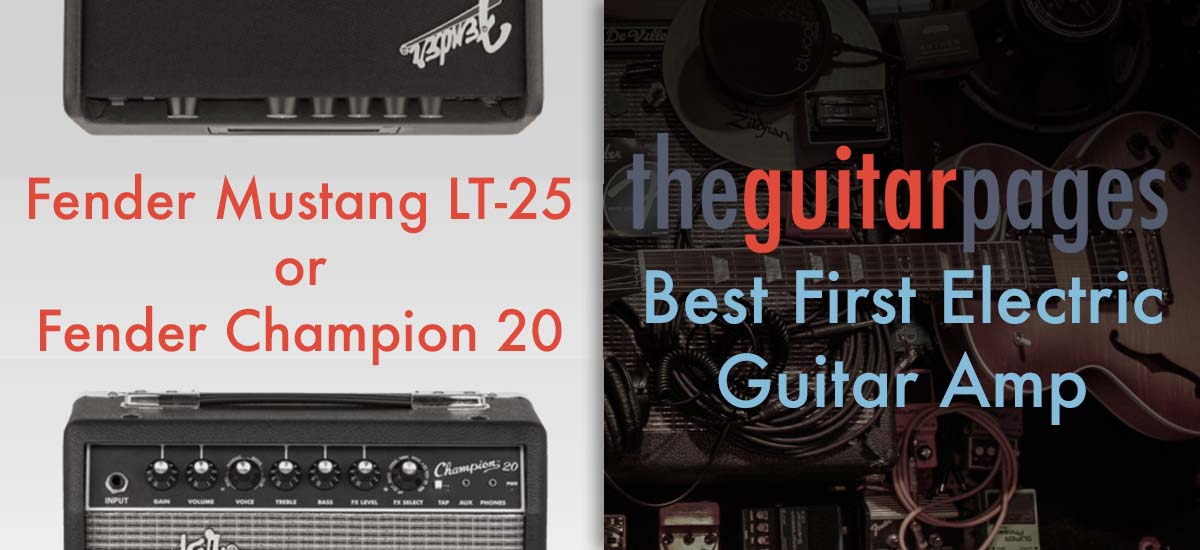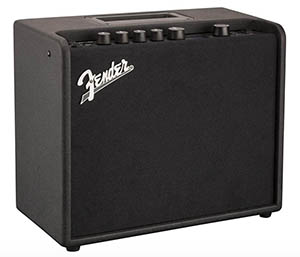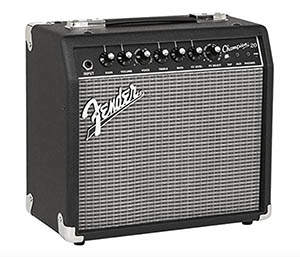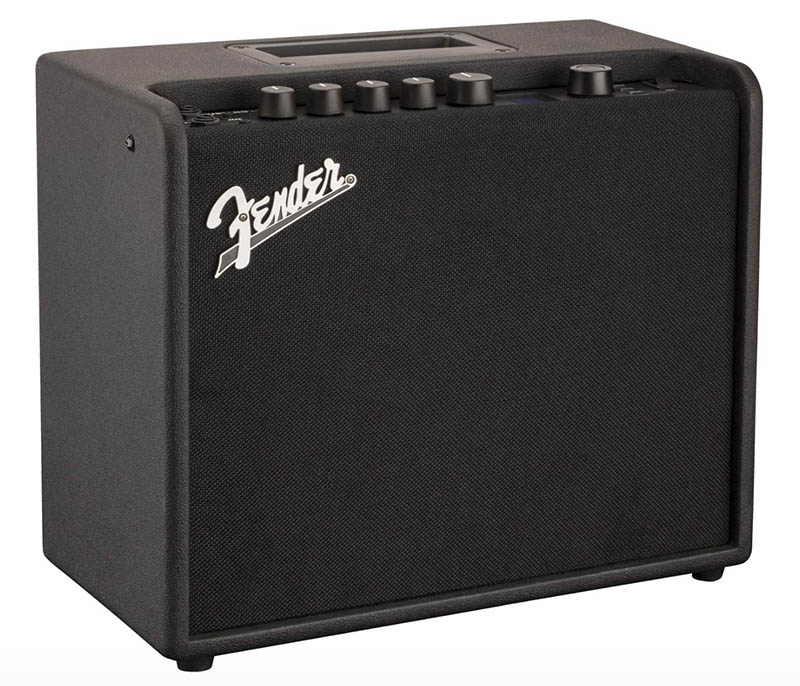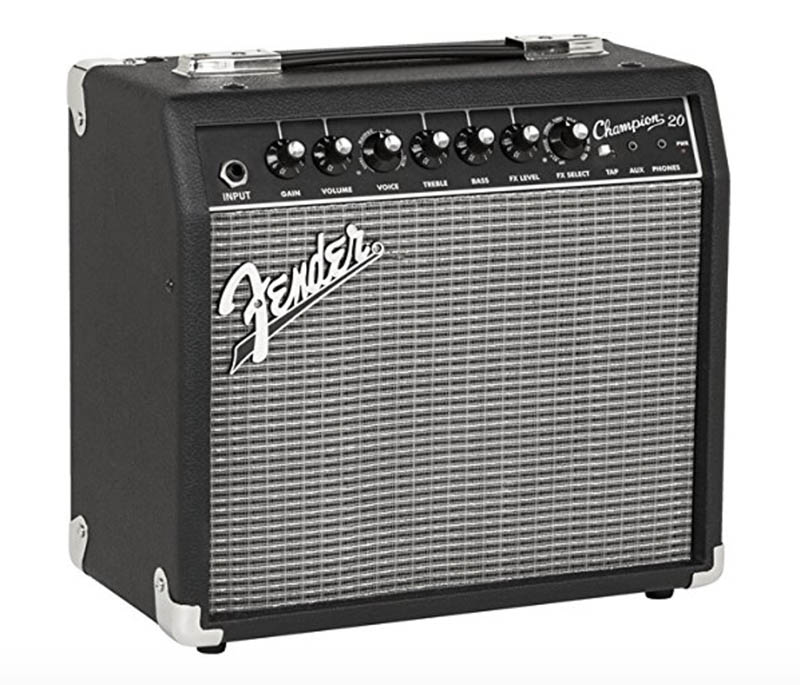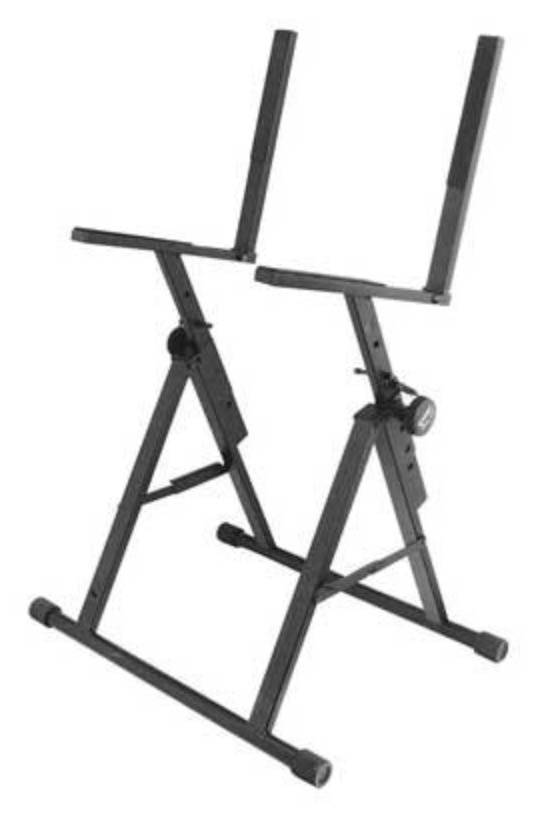updated Jan. 23rd, 2020 to include in-depth reviews and FAQ about beginner amps
You got your first electric guitar, but now you need something to play it through. While there are options for playing an electric guitar without an amplifier, I strongly suggest picking up on of these feature packed beginner electric guitar practice amplifiers. A guitar and an amplifier go together like bagels and cream cheese, and no one wants to eat a plain bagel. Unless you’re a real sicko.
I’m going to make this pretty simple. If you like gadgets, playing around with computers, recording, and tweaking settings to get the perfect tone, go with the Fender Mustang LT25 for your first electric guitar amp. This amplifier is packed full of great sounding models and fun features that will keep newer players exploring their newfound sonic abilities for a very long time. Its affordable price and feature rich set make this our first choice.
The Mustang LT25 offers preset settings out of the box so finding a tone you like is as easy as scrolling through the 30 built in presets. This is the perfect beginner guitar amplifier for younger kids or tech enthusiasts.
If, on the other hand, you like a handful of options that sound great and you don’t have to fuss around to get a sound you like, go with the Fender Champion 20. Instead of an LCD screen this amp utilizes good old knobs to select your amp model and effects. Typically, older players who don’t have any desire to fuss with the screen, or plugging an amp into a computer gravitate towards this amplifier. This is the perfect beginner guitar amp for older players.
There are two must have features in a beginner guitar amplifier, a headphone jack, and an auxiliary input. Both of these amps have both of these features. Hook up your phone, CD player, or computer to the amp to play along with your favorite songs. Plug in a pair of headphones to not drive the rest of your household crazy, and play to your heart’s content.
Table of Contents
What Makes a Good Beginner Guitar Amplifier
While there are specific things that I look for when choosing a good beginner amplifier, it really comes down to what will most inspire a new player to sit down with their guitar and play. If too many fancy models will be frustrating then I suggest going with something simpler. If models, effects, presets, and software is exciting to the player and will enrich their experience I point them in that direction.
Again, the biggest thing is finding the amp that gets the beginning guitar player excited. I hate to say it, but a piece of gear that causes frustration or boredom will do more harm to a beginning guitar player than nearly anything else.
With that in mind, here are some specific things by which I judge a practice guitar amplifier.
Amp Models
What are amp models? Models in an amplifier are sonic lenses which are designed to emulate well known amplifiers. Love the sound of Eric Clapton from the John Mayall and the Bluesbreaker days? There’s a Marshall Bluesbreaker model that emulates the sound and feel of that amplifier. How about a Marshall full stack like Hendrix used to play? There’s a model for that too.
While amp modeling of the past has received some well deserved criticism for being 2 dimensional and poorly executed, modeling tech has come a long way. Even in inexpensive modeling units like these, the emulation is surprisingly good.
When I was learning to play, modeling units were only for professional musicians and high end studios. There were no options for young players. I would save up my lawn mowing money to buy single effects pedal units in order to change my tone from clean to something a little more interesting to my 13 year old ear.
Amp models are an awesome opportunity to try out a large range of sounds and learn what styles of music you like playing the most. I find that younger players gravitate towards these modeling amps and have no problem dialing in the tone and effects that they want quite easily.
Headphone Jack
As mentioned above, a headphone jack is one of the most important features of a beginner electric guitar amp. Especially during the experimentation phases, everyone in the house (or block) doesn’t need to be subjected to the, shall we say interesting, sounds coming out of the amp.
A headphone jack will ensure the sanity of your family.
I often find that younger players can be self conscious of playing through an amp in the early days because they don’t want their mistakes amplified for everyone to hear. A pair of headphones to play through for a beginner who is a bit more shy can be a great way for them to feel comfortable when starting out.
Auxiliary Input
One of the most important ways to get better at guitar is playing with and emulating those guitar players and songs you like the most. This process not only keeps you interested in the music that you’re playing, but it is essential in training your ear to be able to play what you hear.
One thing I wish I would have done more when I was starting out was to learn more songs by ear. I was very quick to grab the tabs off the internet and fumble through those. Ear training is the single most important skill that a beginning musician can develop. Having an auxiliary input so that the music you want to play along with is coming through the same amp that your guitar is coming out of makes playing with your favorite music much easier.
The auxiliary inputs on a practice amp are not colored by whatever model or effect is selected for your guitar tone. The music you’re piping into the amp will come out crystal clean even if your guitar setting is distorted.
Size and Weight
While some beginners, especially those influenced by guitarists like Eddie Van Halen may feel like bigger is better, having a lightweight practice amp will make trucking it around much easier.
Practice and beginner amplifiers will be in the smaller size to facilitate ease of transportation while also retaining all the necessary features and tone. A beginner amp should be lightweight. We can save the 100 watt Marshall full stacks for a little bit later.
Watts
Simply put, watts are a measurement of how much volume an amp will produce. For beginners, a 20 watt amp works just fine. If you’re playing in your room, or live in an apartment you’ll most likely be playing with headphones some of the time in which case overall volume isn’t an issue.
The wattage of an amp is often found in the name. The Fender LT25 is 25 watts, and the Fender Champion 20 is 20 watts. Pretty simple.
When you start playing with more people, then you may want a louder amp. For instance, if you’re playing with a drummer, then you should look at 40 watts and up. This applies to what’s called solid state amplifiers (like the ones in this article). If you’re using an all tube amp, something as low as 5 – 15 watts can work for playing with a drummer.
Though watts are measured the same way, solid state watts are generally quieter than the same watt rating from an all tube guitar amp. This doesn’t make it better or worse, just something to keep in mind while looking at amplifiers.
Tone
If you have found yourself in the depths of any guitar forums on the internet, first my condolences and congrats on making it out alive, and second you’ve undoubtedly seen the myriad of discussions around tone. Everyone has an opinion on tone and amplifiers are often the epicenter from which all tone conversations spring.
While beginner guitar amps aren’t primarily focused on the nuance of tonal nirvana, they are voiced specifically to handle the wide range of sounds that the built in models and effects provides.
While I have heard some less than stellar practice amps, gone are the days of cheap flubby speakers that sound paper thin. The quality of these amps has increased dramatically and you’ll have no issues tone in these beginning stages.
Other Features
Recording
Whether you want to start recording music, or use it as a practice tool to measure progress against benchmarks, having a way to record your guitar playing can be both fun and extremely helpful when learning guitar.
Historically in order to record anything you’d have to invest in a microphone, cables, stands, some type of interface, and recording software. That could easily run you hundreds if not thousands of dollars.
These days, practice and beginner amps include recording software, and have a USB connection which plugs into your computer for any recording you want to do. As mentioned, this is a great way to listen back to your playing to hear progress and expedite the learning process.
Software to Manage Profiles
Sometimes, modelling amps will come with additional software to help manage model presets and profiles. Profiles can be downloaded from either official sources, or are user created. These parameters can then be uploaded into the amp which will take on the new configuration.
This can be a fun way to find new sounds, interact with the community, and manage your presets from a piece of software or even your mobile device, like the Fender Mustang GT40.
In-Depth Beginner Amp Reviews
Fender Mustang LT25
The Fender Mustang line of guitar amplifiers have been bringing flexible and interesting amp models and effects models into these smaller form factor practice amps for almost a decade now. The Mustang LT25 is the latest addition to this line and doesn’t disappoint.
Fender LT25 Mustang Electric Guitar Amplifier, Amazon
Mustang LT25 Features at a glance:
- 25-watt combo amplifier
- 50 Amp Presets
- 26 Effects
- Connect to a computer for recording
- Headphone and Auxiliary Jacks
- Built in tuner
- Great for any young player

It contains all the typical controls you’ll see on a guitar amplifier with the convenient addition of a gain, volume, AND master volume control. Learn more about how to set these controls in Volume, Gain, Master Volume: Set Correctly on Your Guitar Amp. Treble and Bass tone stack allow you to voice the amp model to exactly what sounds best with your guitar.
The “Encoder” knob to the right of the screen allows you to select the amp setting that you want. These amp models range from a Fender clean amp tone modelled after such genre defining amplifiers like the Twin Reverb and the Deluxe Reverb to Rock and Metal amp tones modelled after Marshall Super Leads and Mesa Boogie Dual Rectifiers.
Diving deeper into each setting allows the addition of effects in 4 different categories. Stomp (distortion), Modulation, Delay, and Reverb. Each category has specific effects units which can be added and tweaked to get the exact tone you want.
There are 26 different effects that can be added to your sound in the LT25. This is an awesome way to get to try out all of the different effects that are out there. Heck, most single effects units costs as much as this entire amp costs, so you really can’t go wrong here.
My favorite settings are The Fender Deluxe Reverb clean setting, labeled as DELUXE CLN, and the Fender Champ model, labeled appropriately CHAMP.
One of the most convenient features on this amplifier is the built in tuner. Hold the TAP button and a full chromatic tuner displays on the screen. Having a built in tuner like this saves you from having to buy a floor or clip-on tuner.
Auxiliary in allows you to play along with your favorite music, and as noted previously the amp model or effect doesn’t change the auxiliary input, so your music plays nice and clear while your guitar retains whatever sounds you’ve customized for it.
Size and Weight
The Fender Mustang LT25 is a great size for packing around or just storing in the corner when not in use. It is 12.75” tall, 14.5” wide, and 8.25” deep. The amp weighs in at only 12.75 lbs. This is a great option for a young kid or an older person who’d rather not lug around anything too heavy.
If you want even more options, like bluetooth, wifi connectivity, and a dedicated smartphone app that allows for ultimate customization, check out the Fender Mustang GT series.
Fender Champion 20
There are a lot of older players out there that would rather not mess around with any modern tech. And I totally get it. I’d rather be playing with 12 options than have a million options on a little screen.
Fender Champion 20 Electric Guitar Amplifier, Amazon
The Fender Champion 20 has been in their product line up for decades now, and while you may think that the newer sleek modelling amps would completely overtake the beginner electric guitar amp market, the Champion 20 is proof that that is not the case. There is still a strong market for simple amps that sound great at the turn of a very simple knob.
The Fender Champion 20 is the perfect combination of options and ease of use. The amp has 12 presets from beautiful clean tones to rock and roll distortion. With all of the standard effects, it’s easy to dial up a tone you like.
Take a look at this panel.

That is the panel of an amp that gives you just the options that you need with no fluff. While the Mustang LT25 gives you 20 different amp models that mimic a plethora of classic amps, the Champion distills these sound down into just 4 categories. Tweed (classic 50’s fender tones), Blackface (Fender’s famous amps from the 60s named after the black control panel), British (higher gain Rock and Roll amps like Marshall), and Metal (typically Mesa Boogie, and other high gain amps).
Some players welcome the simplification, and others are looking for more options and customizability. I find that younger players and tech comfortable players gravitate toward that LT25 and those who would see the screen and have a negative reaction are quite fond of the simplicity offered by the Champion 20.
The Champion 20 also comes with an auxiliary input for playing along to your favorite music, and a headphone jack for silent playing.
Downside
The downside of the Champion 20 is that there is no onboard tuner. While this isn’t the end of the world and there are some great clip-on tuners on the market, the built in tuner of the LT25 is incredibly helpful.
Size and Weight
The Champion is a great size and weight for a practice amp at 12.75” tall, 13.75” wide, and 7.5” deep. It weighs in at 12 lbs, making the Champion 20 slightly smaller and lighter than the Mustang LT25. Barely enough to make a difference, but slightly smaller.
The Fender Champion 20 practice electric guitar amp is a great beginner amplifier for someone looking for a simplified amp that contains a wide range of sounds to accomodate any genre and style of playing.
Common Beginner Electric Guitar Amp Questions
What Does a Footswitch Do on an Amp?
A footswitch is most commonly used to switch between two or more channels. For footswitches with one button, this is most likely going to be used to switch between a clean and distorted channel or preset.
Because of the flexibility that modelling amps typically give you, you can create two presets that you like and use the footswitch to switch between these two presets in real time. The most common example of this is finding a great clean rhythm tone and saving that into the first preset. You then create a tone that has a little more distortion or boost that can be used as a lead solo tone. This is saved into the second preset and the footswitch is used to switch between your clean and lead sounds within a song.
The LT25 allows the use of a footswitch in this way, as do most digital modelling amplifiers with the ability to customize and save presets.
The Champion 20 does not accept a footswitch and all tone adjustments have to be made on the amp itself.
More complex footswitches exist to control other functions like access to more presets, effects, or tuner functions. If you’re interested in more advanced tonal options via footswitch check out the Mustang GT40 which can take a 4 button footswitch to maximize the options offered by the amplifier. If you’re planning on doing any sort of live playing, this setup is definitely the way to go. However, not necessary when just starting out and looking for a practice amp.
Do You Need to Have an Amp Stand?
While you certainly don’t need an amp stand to use your guitar amplifier effectively, there are advantages to using one.
If you have an amp sitting on the floor down by your feet, all the volume is directed at your shoes. This means that you’re going to have to turn the amp up in order to hear it correctly. By getting the amp up higher, off the floor, and pointed in the direction of your ears, you can turn the amp’s volume down considerably which makes everyone happy.
The other major advantage is not having to bend over so far to adjust your amp, or see what your amp settings are. This can be extremely helpful for older players who use reading glasses to see smaller type. An amp on the floor is just far enough away to make it a real pain to both see and bend over to make adjustments.
While there are cheaper amp stands, I like the On-Stage stand the most because it has a height adjustment and can get the amp higher than any of the other stands on the market. Consider getting a guitar amp stand to save your back from bending over, your ears from turning it up too loud, and your eyes from squinting at the small panel type when it’s on the floor.
Conclusion
If you’re a beginning guitar player looking for an electric guitar amplifier to pair with your electric guitar, there are a ton of options out there which can be pretty daunting. These are my favorite amps for beginner players both because of their reasonable price, but also the number of features and sounds that make both of these amps a useful option for any player interested in any genre of music.
You can’t go wrong with either the Fender Mustang LT25 or the Fender Champion 20. After you’ve been playing awhile most guitar players step up into something a bit fancier, like a tube amplifier. However, it’s always nice to have a practice amp that’s lightweight for trucking around or to have in another room of the house.
